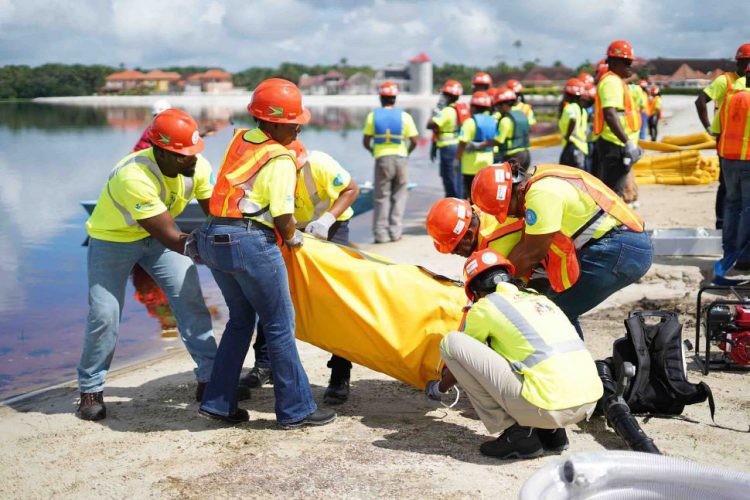Approaching a year since oil production began offshore, the Civil Defence Commission (CDC) is honing its preparedness to tackle spills and it has over 100 trained persons on standby along with containment equipment, according to its Director-General, Lieutenant Colonel Kester Craig.
In an interview with Stabroek News on the capacity to respond to oil spills, small or large, Craig said that with a National Oil Spill Contingency Plan (NOSCP) now in place, key agencies such as the Maritime Administration (MARAD) and the Guyana Defence Force Coast Guard are now required to improve their capabilities and resources to be able to effectively respond.
Craig noted that the risk of an oil spill is higher not only because of offshore oil operations but with more vessels arriving and operating in Guyana’s waters daily.

“Guyana is not that Guyana we knew before. We are an oil producing country now and have to prepare to operate as an oil producing country and we have to improve across the board by offering training, having the right resources, executing exercises in the field as we move forward… MARAD [and the Coast Guard have] key roles in monitoring and needs to building their capacity,” Craig said.
The head of the CDC, which has the responsibility for coordinating the response to an oil spill, emphasised, “People have to start equipping themselves, look at the plan, assess their roles and responsibilities and implement training and begin procurement of equipment,” in order to efficiently respond.
He added that the various agencies have to take a more serious approach towards the monitoring of operations onshore and offshore.
“The risks of an oil spill in our territory or our waters are increasing because of increased activities offshore and the possibility of (a) collision increases,” Craig stated, as he pointed out that most oil spills occur during the transfer of fuel and crude from one vessel to the next.
However, before a response plan of action can be mapped out, Craig explained that there are several procedures that are required to be followed from the time of an oil spill report.
Giving an overview of what this entails, the CDC head said MARAD has the responsibility to continuously monitor operations offshore. While they may not be able to have 100% visuals on the operations, he said they are supported by other agencies such as the Guyana Geology and Mines Commission (GGMC), which has personnel on the rig observing operations and the Aircraft Owners Association which aids in aerial monitoring.
“On the rigs, GGMC is supposed to have a personnel and should be able to identify maybe something is going wrong. You don’t have an oil spill yet but if safety measures are not being followed they can report that to Maritime Administration for action. If for example a small leak or small spill (occurs) they can pass that information on,” he stated.
Craig noted too that the Coast Guard plays a role in monitoring as they often traverse areas in close proximity to large vessels.
Once a spill or leak is detected and the information is verified, the next step will be an assessment to determine the type of pollutant, the amount and trajectory of its impact among others. They will then mobilize a response team.
Craig said that the response team will be determined by the magnitude of the spill and its classification.
Three tiers
In the NOSCP, there are three tiers of response, locally, nationally and internationally. Under the local tier, which is also referred to as tier one, the vessel operator will be responsible for cleaning up the spill.
In the response plan, he stated, it is mandatory for all vessels operating in Guyana to be equipped with oil spill gear so that they can quickly mop up a spill.
“All vessels and all rigs should have their own dispersants, booms, skimmers etc and so one of the things we will do is to … see if they have the oil spill response kit. These vessels have been creating their own response policy but we have to ensure that their plans are in keeping with our response plan,” Craig highlighted.
He noted, too, that they have sent copies of the plan to the various operators and stakeholders to make adjustments to their operational response so it is in line with Guyana’s response.
“Tier two is more of a national response where you have the collaboration of all the national agencies and tier three is more an international response where larger oil companies …have standard agreements with other international companies who deal with oil spill,” he explained.
Craig went on to state that should they have to respond to an oil spill at the national level, they first meet with the National Oil Spill Committee, which is multi-stakeholder committee.
“Once MARAD has the information and details they will come to the CDC which is the competent national authority then what we do is immediately meet to activate fully or partially our oil spill committee and begin a briefing assessment then we determine what the response will be,” he said.
Touching on the response and plan of action, the CDC head stated that they will deploy equipment that was procured a few years ago by the Ministry of Natural Resources.
“We have booms, vacuums, generators Personal Protective Equipment and a hold host of other equipment at our facilities in Timehri. Apart from that too, GAICO Construction they have oil spill response,” Craig said as he explained that they will use all of the necessary resources required to contain the spill. He added that at least eight vessels from the coast guard are part of the response team and they have a list of those vessels.
As it relates to human resources, over 100 persons have been trained in the various fields of oil spill management and are on standby to respond.
“We have over 100 persons, who have been trained in various areas of oil spill response. The CDC has a volunteer emergency response team which is actually sponsored and supported by ExxonMobil, University of Guyana and the Caribbean Disaster Emergency Management Agency…”
Craig also explained that they have 35 young professionals at the CDC who have been trained to aid in an oil spill response.
“We have chemical dispersants… this will be placed on the crude and then disintegrate it and sinks it to the bottom of the sea… for us to use this type of dispersant we will have to get approval from the Environmental Protection Agency,” Craig added.
Expanding on the dynamics of tier three, Craig said that there will be some length of time involved in this response since equipment for that magnitude of clean-up is not always readily available.
It is not feasible for countries or companies to acquire responses and have it on standby for a large scale oil spill because these occurrences are not often, he stated.
In the case of a large oil spill, he noted that they will have to apply dispersants aerially over the affected area.
Asked about the area most likely to be affected by an oil spill, he said from calculations of the current, wind and tide it will be in the Barima-Wani region in the North West.
If a spill occurs approximately 200 nautical miles offshore, Craig said it will take at least two weeks to reach the coast, giving them time to prepare containment measures.










